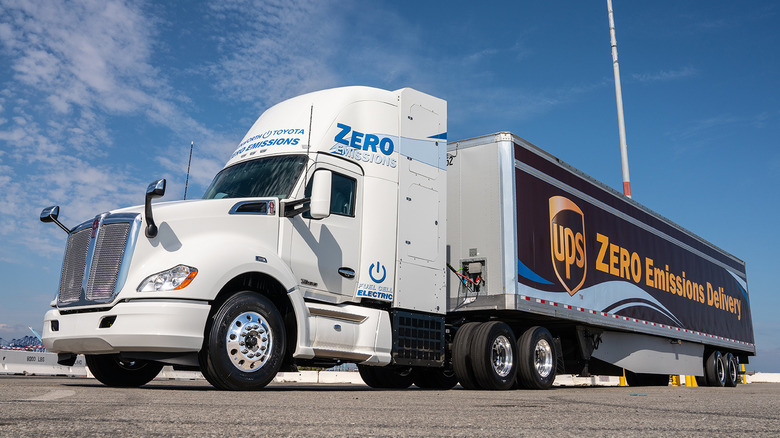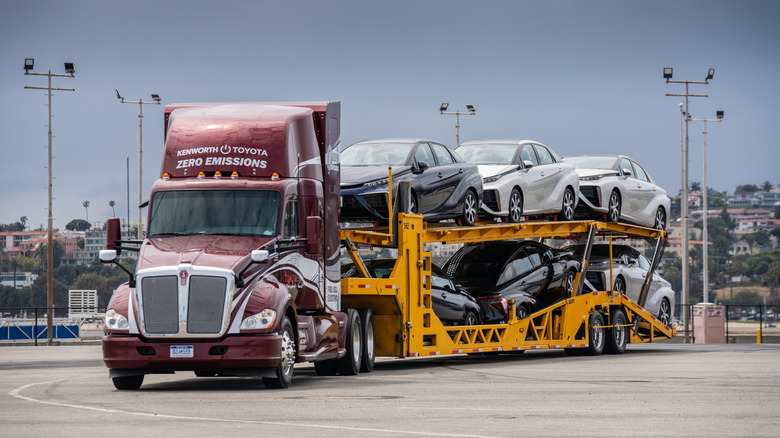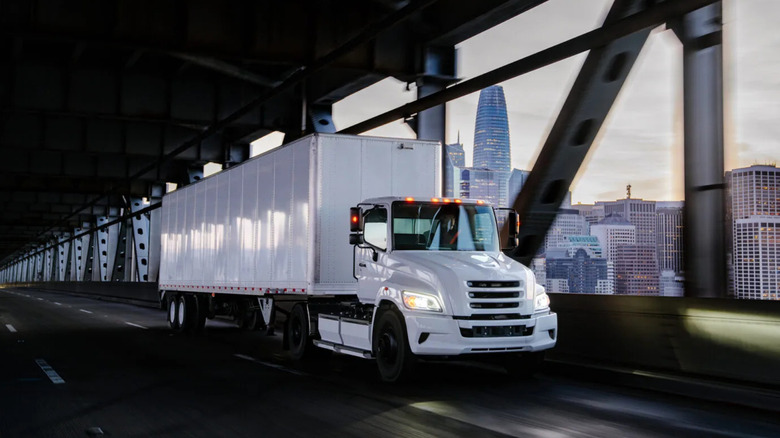Does Toyota Make Commercial And Heavy Duty Trucks?
Toyota is the largest automotive company by sales volume in the world, a title not earned or retained easily. While they're most well-known for their passenger cars like the Corolla, Land Cruiser, and Camry, they also produce a number of other products and services for more specialized work outside of the passenger automotive industry. For instance, there's Toyota Financial Services, Toyota Housing, Toyota Marine, and commercial products from Toyota Industries including everything from forklifts to textile machinery — appropriate, considering Toyota actually began as a textile manufacturer.
Alongside these, Toyota also owns Hino, a subsidiary dedicated to producing heavy-duty commercial vehicles like trucks and buses, and Toyota is currently expanding its program developing hydrogen fuel-cells for use in Class 8 semi-trucks. Lastly, Toyota owns a 30% stake in Aichi Steel, manufacturing various steel and metal components for industrial and commercial use, especially within the automotive industry.
Toyota's history producing commercial trucks dates back to the 1930s, producing trucks like the FC due to rising demand for heavy-duty vehicles in Japan. This time period was characterized by rapid development and expansion following the devastation sustained during World War II, labeled as "The Japanese Miracle."
Many commercial vehicles of virtually all sizes ranging from kei trucks to heavy-duty haulers found purpose throughout this era, including a number of Toyota and Hino innovations such as early full-size buses and semi-trucks. Toyota has, of course, expanded dramatically since these early days, but they maintain solid links to their commercial heritage and continue producing and developing various equipment, from Class 8 haulers to the $13,000 Hilux Champ pickup. Let's take a look at their various products and services.
Toyota heavy-duty trucks
The first truck to wear a Toyota badge was the 1935 Toyoda G1, which was effectively the Japanese equivalent of a GMC CCKW or Opel Blitz. Toyota developed an early reputation for solid military trucks throughout World War II, with vehicles like the KC produced until 1947. As demand swelled following the reconstruction of Japan, Toyota began producing larger articulated vehicles like the FC throughout the 1950s, filling a necessary niche as Japan's main indigenous heavy-hauler. Toyota produced these early models from 1954 to 1964 alongside passenger car production.
Owing to Toyota's recent history with alternative fuels made popular by cars like the hydrogen-powered Toyota Mirai, modern Toyota trucks are similarly best-known for their utilization of advanced efficiency technology, especially hydrogen fuel cells. Officially called the Toyota FC Stack, this project utilizes a Hino Profia chassis coupled with a proprietary hydrogen fuel cell powerplant featuring two cell stacks developed for the Mirai.
As of 2025, Toyota's plans include infrastructure development in the United States, with new hydrogen fuel stations, a Generation 3 fuel cell system, and the introduction of commercial hydrogen-powered trucks to select locations in Southern California for real world data and assessment. As such, despite not being in the limelight like dedicated truck manufacturers, Toyota still owns Hino, and its own commercial truck history is actually longer and just as influential as its better-known passenger car legacy.
Other Toyota commercial vehicles
The Japanese manufacturer also produces a number of other specialized commercial vehicles aside from trucks. For instance, Toyota is particularly famous for its line of forklifts, and that's no accident. In fact, Toyota invented the forklift we know today, with a counterbalanced lifting fork mechanism, in 1955 with the Model LA-1.
Toyota subsequently diversified its fleet, incorporating electric and diesel forklifts able to lift several tens of tons, including a range of attachments and fork options, and expanded into the U.S. market. In 2001, the company established Toyota Material Handling, a division which specializes in forklift production, logistics, and warehouse operating services.
Hino produces a number of its own vehicles aside from its reputable truck fleet, primarily buses and other logistics vehicles. The company has largely shifted its focus towards sustainability, including innovations in FCEV and battery-electric commercial vehicles, hydrogen infrastructure development, and logistical carbon-neutrality throughout the manufacturing and production processes of such vehicles. Hino first established itself in North America in 1983, producing trucks, buses, and diesel engines, branching off into parts distribution in 2005. The company also maintains a large international presence in Europe and Asia, with popular small and heavy-duty buses in cities throughout the world today.
All Toyota vehicles оbviously require manufacturing, and Toyota has this step covered as well. Namely, Aichi Steel, a steelworks manufacturer based in Tokai City of the Aichi Prefecture, falls under Toyota Industries' banner, providing industrial and manufacturing materials for Toyota's passenger and commercial lines. Essentially, Toyota has at least one dedicated branch for nearly every step of the commercial industry, from raw materials to manufacturing and logistics.


